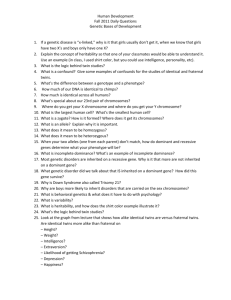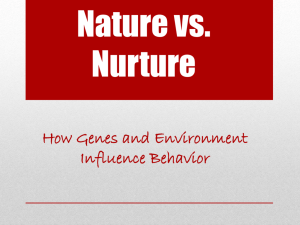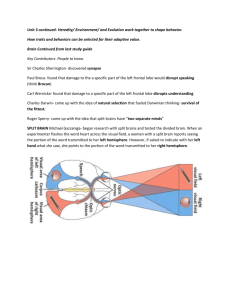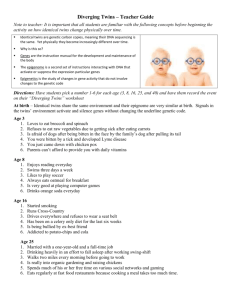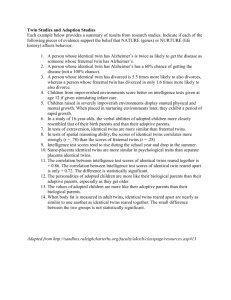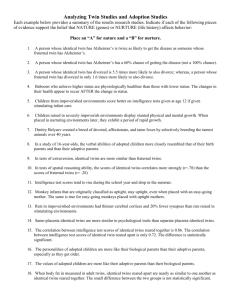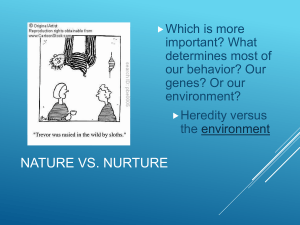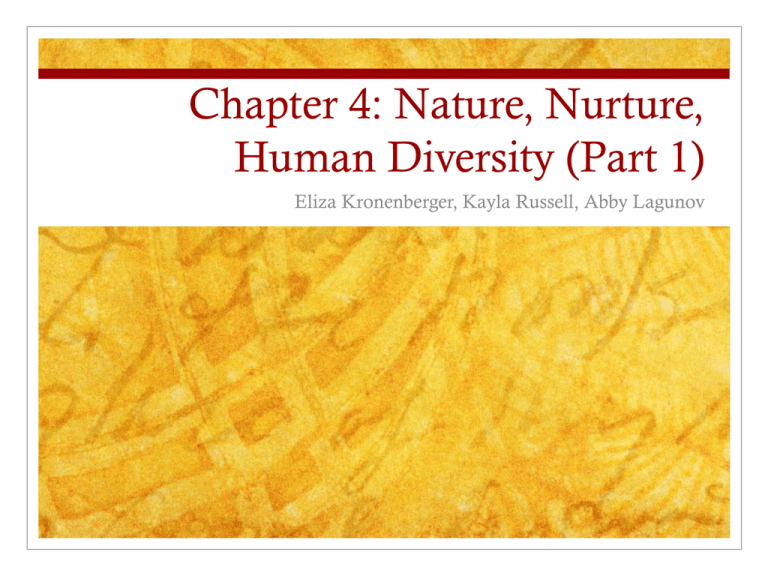
Chapter 4: Nature, Nurture,
Human Diversity (Part 1)
Eliza Kronenberger, Kayla Russell, Abby Lagunov
A biological aspect of taste that humans prefer is the
taste of sweets.
We start to fear strangers at around 8 months old.
3 universal behaviors of humans:
-dancing/feasting
-singing/worshipping
-playing sports/games
Behavior
Genetics/Environment
Study differences and weigh effects in the interplay
of heredity and the environment.
Cell Nucleus
Every cell nucleus in the body contains a genetic
master code for the entire body.
Definitions:
DNA: Complex molecule containing genetic
information that makes up chromosomes.
Chromosome: Threadlike structures made of DNA
molecules, contain genes.
Genome: Complex instructions for making an
organism, consisting of all genetic material in an
organism’s chromosomes.
“We shared half our genes
with the banana.”
Proves that slight variation change in genetics causes
vast differences.
Types of Twins
Identical Twins: Twins who develop from a single
fertilized egg, splits in 2 creating 2 genetically
identical organisms.
Fraternal Twins: Develop from separate fertilized
eggs- genetically no closer than ordinary
brothers/sisters, but share fetal environment.
Fraternal Twins
Fraternal twins are not any more similar than an
ordinary brother/sister.
Alzheimer’s Disease
If a person has Alzheimer’s disease, an identical twin
has a 60% chance of getting this disease. A fraternal
twin has a 30% chance.
Matt McGue and David
Lykken Study (1992)
Followed divorce rates of 1,500 same-sex, middle-aged
twin pairs.
Results: Fraternal twin who is divorced- odds of
divorce go up 1.6x (compared to not divorced twin)
Identical twin who is divorced- odds of divorce of
other twin go up 5.5x
Importance of Genes
Genes do not matter in explaining individual
differences.
Quote: Bouchard
“In some domains it looks as though our identical
twins reared apart are… just as similar as identical
twins reared together. Now that’s an amazing finding
and I can assure you none of us would have expected
that degree of similarity.”
Even if twins are separated, biologically (with genes)
interests are similar.
Bouchard’s Critics Theory
Separated fraternal twins do not exhibit similarities
comparable to those of separated identical twins.
Twin Studies
Twin study results give us a greater appreciation for
genetic influences.
Genetic/Environmental
Relatives
Genetic- Biological parents/siblings
Environmental- adoptive parents/siblings
Does environment impact
personality?
Adoptees more similar to biological parents than to
adoptive parents.
Quote:
“Mom may be holding a full house while Dad has a
straight flush, yet when Junior gets a random half of
each of their cards his poker hand may be a loser.”
Child is not guaranteed the best traits of each parent,
but gets a random selection… No genetic legacy!
Adopted Children
Most adopted children thrive because…
-Attatched to adoptive parents
Many score higher than biological parents on an
intelligence test
Benefits of Adoption
Children grow up happier
More self-giving than average
Temperament
A person’s characteristic emotional reactivity and intensity.
Temperament
Temperament persists over time.
Temperament
Biologically rooted temperament helps form our
enduring personality: one form of a gene that
regulates the neurotransmitter serotonin predisposes
fearful temperament and inhibited child.
Heritability
Proportion of variation among individuals that we
can attribute to genes. The heritability traits may
vary.
Environment Similarities
As environments become more similar, heredity (as a
source of differences) become more important.
Self Regulating Genes
Genes react, rather than acting.
Eating Disorders
Human differences result from both genetic and
environmental influences.
For example, eating disorders are genetically
influenced- some people are at more of a risk than
others.
Gene-Environment
Interaction
Genes and experiences are both important, but they
interact.
Interaction: Interplay that occurs when the effect of
one factor (such as the environment) depends on
another factor (heredity).
“Heredity deals the cards;
environment plays the hand.”
Biology starts off a person’s life- personality develops
and changes them from the society around them.
Nature/Nurture
Think “Nature VIA Nurture” instead of “Nature Vs.
Nurture”.
Molecular Genetics
Subfield of biology that studies molecular the
molecular structures and functions of genes.
Molecular Behavior
Genetics
Goal: to find some of the many genes that influence
normal humane traits, such as baby weight, sexual
orientation, extraversion, and also explore
mechanisms that control gene expression.
“Missing Women”
Men/boys are favored in India and China... Girl
children are often killed or given away. This is a
problem now because there are too many boys in this
area and a shortage of girls.
Evolutionary Psychologists
The study of the evolution of behavior and the
mind, using principles of natural selection.
Natural-Selections
The principle of the survival of the fittest
Belyeav & Trut: Fox Study
In this study, wild foxes were collected and the most tame of these
were mated with one another. Over a few decades, these animals
became completely domesticated.
Mutations
A random error in gene replication that leads to a change
Universal Actions
Example: A loved one of any culture in the world is
greeted in the same way.
Predisposition to Tastes
Humans are predisposed to love sweet and fatty tastes.
Outcome?
This love of sweet/fatty foods has led to obesity in Western cultures.
Harms of Industrial
Revolution
Our bodies are not wired for this type of world- with
such mass productions.
It has also adjusted us to live by a clock schedule.
Darwin
All current scientists agree with Darwin’s ideas.
Two Questions of
Evolutionary Psychologists?
What are the mental differences between men and women?
How do genes shape our current environment? (Nature VIA Nurture)
Gender difference in
Sexuality
Men have a much stronger sex drive than women.
Pryor’s study on attitudes
towards casual sex:
Discovered that about 58% of men favored casual sex, while only
34% of women did.
Fischstein’s study on
sexual thoughts:
About 46% of men think about sex throughout the whole day.
This is about the same for both Canadians and Americans.
3 Differences between gay
men and lesbian women:
Gay men report more interest in un-committed sex compared to
women
More responsive to sexual stimuli
More concerned with physical attractiveness
Clark and Hatfield’s Study:
Had university students wander around the campus and say that other
random students were attractive.
¾ of men agreed: 50% to a cup of coffee, 75% to sex
No women agreed.
Approaches to sex:
Men: Approach is more recreational
Women: Approach is more relational
4 characteristics that men
find attractive:
Healthy women
Fertile (young)
Smooth skin
Youthful shape
Women preferences of
men:
13 year old boy 17/18 year old girl
25 year old boy Same age girl
50 year old boy Younger women
2 Characteristics that
women find attractive:
Being affluent/wealthy
Dominant
Long-Term Mates
Evolutionary psychologists believe that women prefer long term
mates because of their investments in joint offspring.
Roney’s Study on Women
and Baby Pictures:
In this experiment, women skillfully discerned which men most
liked looking at baby pictures, and they rated those men higher as
potential long-term mates.

